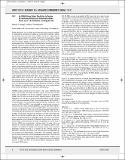An SRAM using output prediction to reduce BL-switching activity and statistically-gated SA for up to 1.9× reduction in energy/access
Author(s)
Chandrakasan, Anantha P.; Sinangil, Mahmut E.
DownloadSinangil_ISSCC_paper_2013.pdf (4.546Mb)
OPEN_ACCESS_POLICY
Open Access Policy
Creative Commons Attribution-Noncommercial-Share Alike
Terms of use
Metadata
Show full item recordAbstract
Mobile applications such as tablets pack increasingly more processing capability comparable to workstations or laptops but can do little for cooling or extending the battery life in their form factors. SRAMs account for a large fraction of chip area and are critical in this context. Recent work has focused on voltage scaling in SRAMs, which is an effective way of achieving energy efficiency [1,2]. These conventional SRAMs are mostly general-purpose in the sense that they are designed without considering the specific features of the data they will store. However, application-specific features such as statistics of storage data can be exploited and incorporated into the transistor-level design to provide a new dimension towards achieving the next level of energy savings in addition to the savings provided through voltage scaling. The work in [3] is an example where an inversion bit is added for each word to reduce read-bitline (RBL) transitions in an 8T-cell-based design with a single-ended read port. Similarly, the work in [4] stores only the LSBs of each word in 6T SRAMs where occasional bit-errors at low voltages are tolerable for its application. In this work, we focus on video; however, the ideas can be generalized to different applications. In video encoders, pixel processing is performed over large partitions of image frames (e.g., 192×192 pixels), which are stored in on-chip SRAMs and accessed frequently. Image frames generally consist of smooth backgrounds or large objects where the intensity of pixels is spatially correlated. For the video image frame in Fig. 18.2.1, the deviation of each pixel's intensity from its block average for a 16×16 block shows that 76% of pixels lie within 3 LSB of the average. This additional information can be used to design an SRAM where correlation of data is used to reduce bitline activity factor which, for an 8T SRAM in a 65nm low-power CMOS process, accounts for ~50% of total energy consumption during read a- cesses at 0.6V. In this work, we present a prediction-based reduced-bitline-switching-activity (PB-RBSA) scheme along with a hierarchical sensing network with statistical sense-amplifier gating to exploit the correlation of storage data. Reduction of switching activity on the bitlines and in the sensing network of the memory provide up to 1.9× reduction in energy/access.
Date issued
2013-02Department
Massachusetts Institute of Technology. Department of Electrical Engineering and Computer ScienceJournal
Proceedings of the IEEE International Solid-State Circuits Conference - Digest of Technical Papers, 2013
Publisher
Institute of Electrical and Electronics Engineers (IEEE)
Citation
Sinangil, M. E., and A. P. Chandrakasan. “An SRAM Using Output Prediction to Reduce BL-Switching Activity and Statistically-Gated SA for up to 1.9× Reduction in Energy/access.” 2013 IEEE International Solid-State Circuits Conference Digest of Technical Papers (February 2013).
Version: Author's final manuscript
ISBN
978-1-4673-4516-3
978-1-4673-4515-6
978-1-4673-4514-9
ISSN
0193-6530